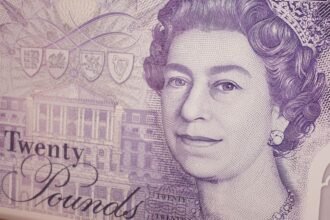- GBP/USD trades at its highest level since February 2022 near 1.3500.
- Retail Sales in the UK rose at a stronger pace than expected in April.
- The US Dollar stays under heavy selling pressure on fiscal concerns.
After struggling to find direction on Thursday, GBP/USD extends its weekly uptrend and trades at its highest level since February 2022 near 1.3500 in the European morning on Friday. The technical outlook points to overbought conditions but the pair’s correction attempts could remain short-lived.
British Pound PRICE This week
The table below shows the percentage change of British Pound (GBP) against listed major currencies this week. British Pound was the strongest against the US Dollar.
| USD | EUR | GBP | JPY | CAD | AUD | NZD | CHF | |
|---|---|---|---|---|---|---|---|---|
| USD | -1.41% | -1.58% | -1.32% | -1.19% | -0.88% | -1.20% | -1.25% | |
| EUR | 1.41% | -0.19% | 0.15% | 0.29% | 0.68% | 0.28% | 0.17% | |
| GBP | 1.58% | 0.19% | 0.04% | 0.48% | 0.87% | 0.47% | 0.36% | |
| JPY | 1.32% | -0.15% | -0.04% | 0.15% | 0.62% | 0.33% | 0.13% | |
| CAD | 1.19% | -0.29% | -0.48% | -0.15% | 0.32% | -0.01% | -0.12% | |
| AUD | 0.88% | -0.68% | -0.87% | -0.62% | -0.32% | -0.39% | -0.48% | |
| NZD | 1.20% | -0.28% | -0.47% | -0.33% | 0.01% | 0.39% | -0.11% | |
| CHF | 1.25% | -0.17% | -0.36% | -0.13% | 0.12% | 0.48% | 0.11% |
The heat map shows percentage changes of major currencies against each other. The base currency is picked from the left column, while the quote currency is picked from the top row. For example, if you pick the British Pound from the left column and move along the horizontal line to the US Dollar, the percentage change displayed in the box will represent GBP (base)/USD (quote).
The UK’s Office for National Statistics reported early Friday that Retail Sales rose by 1.2% on a monthly basis in April, following the 0.1% increase recorded in March. This print came in better than the market expectation of 0.2% and boosted Pound Sterling to begin the European session.
On the other hand, the US Dollar (USD) stays under strong selling pressure after managing to keep its footing on the back of upbeat flash S&P Global Purchasing Managers Index (PMI) data releases for May on Thursday. Investors grow increasingly concerned over the US debt staying on an unsustainable path after United States (US) President Donald Trump’s sweeping tax and spending bill passed the Republican-controlled House of Representatives on Thursday.
The bill now moves to the Senate, which will kick off deliberations after the Memorial Day holiday and will try to have a vote before July 4.
In the absence of high-impact macroeconomic data releases, the USD could have a difficult time finding demand heading into the weekend, allowing GBP/USD to end the week decisively higher.
GBP/USD Technical Analysis

The Relative Strength Index (RSI) indicator on the 4-hour chart rose above 70 for the first time since late April, reflecting overbought conditions in the near term.
On the downside, 1.3440-1.3450 (static level, former resistance) aligns as immediate support before 1.3400 (static level, round level) and 1.3360 (50-period Simple Moving Average). Looking north, additional gains toward 1.3560 (static level from February 2022) and 1.3600 (static level, round level) could be seen once GBP/USD stabilizes above 1.3500 (static level, round level).
Pound Sterling FAQs
The Pound Sterling (GBP) is the oldest currency in the world (886 AD) and the official currency of the United Kingdom. It is the fourth most traded unit for foreign exchange (FX) in the world, accounting for 12% of all transactions, averaging $630 billion a day, according to 2022 data.
Its key trading pairs are GBP/USD, also known as ‘Cable’, which accounts for 11% of FX, GBP/JPY, or the ‘Dragon’ as it is known by traders (3%), and EUR/GBP (2%). The Pound Sterling is issued by the Bank of England (BoE).
The single most important factor influencing the value of the Pound Sterling is monetary policy decided by the Bank of England. The BoE bases its decisions on whether it has achieved its primary goal of “price stability” – a steady inflation rate of around 2%. Its primary tool for achieving this is the adjustment of interest rates.
When inflation is too high, the BoE will try to rein it in by raising interest rates, making it more expensive for people and businesses to access credit. This is generally positive for GBP, as higher interest rates make the UK a more attractive place for global investors to park their money.
When inflation falls too low it is a sign economic growth is slowing. In this scenario, the BoE will consider lowering interest rates to cheapen credit so businesses will borrow more to invest in growth-generating projects.
Data releases gauge the health of the economy and can impact the value of the Pound Sterling. Indicators such as GDP, Manufacturing and Services PMIs, and employment can all influence the direction of the GBP.
A strong economy is good for Sterling. Not only does it attract more foreign investment but it may encourage the BoE to put up interest rates, which will directly strengthen GBP. Otherwise, if economic data is weak, the Pound Sterling is likely to fall.
Another significant data release for the Pound Sterling is the Trade Balance. This indicator measures the difference between what a country earns from its exports and what it spends on imports over a given period.
If a country produces highly sought-after exports, its currency will benefit purely from the extra demand created from foreign buyers seeking to purchase these goods. Therefore, a positive net Trade Balance strengthens a currency and vice versa for a negative balance.





















